Holy Week in Valladolid
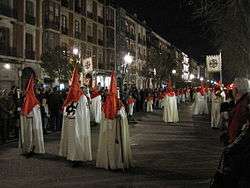
.jpg)
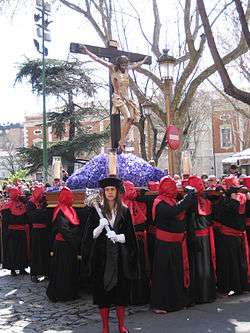

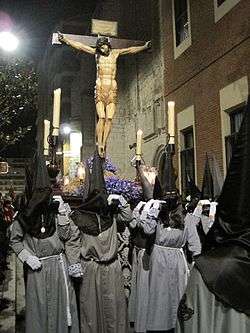
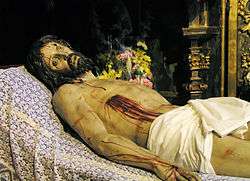

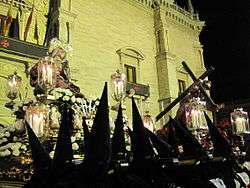

Holy Week of Valladolid is one of the main cultural events, religious and tourist attraction of Valladolid and the province during Holy Week. Their carvings are among the greatest artistic value of the world in polychrome sculpture, mainly thanks to image makers like Juan de Juni and Gregorio Fernández,[1] assets in the period in which the city was imperial court. The National Sculpture Museum of the city gives a total of 104 images (distributed in the corresponding pasos) to the processions, such as fact museum unique in Spain.[2] The Holy Week in Valladolid has been described as the representing with greater fidelity, rigor and detail the passion.[3]
In addition to the artistic value and catechetical programs of its religious imagery, the Week is characterized by devotion, sobriety, silence[4] (different from processions of Andalusia) and respect of the brotherhoods and the public, and by unique acts as the "General Procession of the Sacred Passion of the Redeemer"[5] and "Sermon of the Seven Words" in Plaza Mayor, which recalls to the autos de fe 16th century. For all these reasons, this celebration was declared of International Tourist Interest in 1980 (the first week Spanish Saint to hold such declaration), and in 2014 started the paperwork to get their recognition as intangible cultural heritage.[6]
Brotherhoods
The 20 brotherhoods (5 were historical and the rest were created from 1920) of the city had a total of 59 different pasos, which are described within the brotherhood owner of each paso, and held a total of 33 processions (to which must be added the "Proclamation" and "Sermon of the Seven Words").[7]
Processions
The processions begin the Friday before of Good Friday and will happen until the Sunday of Resurrection. Hundreds of penitents or cofrades take part on the parades, either carrying the pasos or walking the old streets of the city with crosses, flags or candles. Thousands of people, locals and visitors attend the events. The silence is only interrupted by the sound of drums and trumpets. The pasos are the core of the festival. They consist of a wooden sculpture or group of sculptures that narrates a scene from the Passion of Christ. They are carried by porters in a platform or staves by the members of Brotherhoods. The processions are organized by hermandades and cofradías (religious brotherhoods). Members precede the pasos dressed in penitential robes with capirotes, (tall, pointed hoods with eye-holes). The capirotes were designed so the faithful could repent in anonymity, without being recognised as self-confessed sinners. Each brotherhood has its own colors, that are seen in the costumes of the members, to distinguish them from other brotherhoods.
The Archbishopric of Valladolid, carefully following the liturgy, has been considering the day of the Holy Saturday as non-liturgical, and therefore, not suitable for holding processions. Based on this consideration, only have a procession of Solitude, in the morning and with absence of any adornment to the image of Nuestra Señora de las Angustias and the transfer of the Recumbent Christ in the afternoon, with the that closes the Passion and we are still waiting for the Resurrection. Special importance is the offer of the headaches to the Blessed Virgin, penitential act that is celebrated in the church of Vera Cruz to the painful of the Vera Cruz and that enjoys great fervor among the members.[8]
The Days of Holy Week
During the Friday and Saturday of Passion Week and into Holy Week itself, the following brotherhoods make their penitential processions in Valladolid, by the order of precedence of their entry into the main church and by the date of their founding.
Friday of Sorrows
- Cofradía del Santo Entierro (Brotherhood of the Holy Burial). 1930.
- Cofradía de la Exaltación de la Santa Cruz y Nuestra Señora de los Dolores (Brotherhood of the Exaltation of the Holy Cross and our Lady of Sorrows). 1944.
Passion Saturday
- Cofradía Penitencial de la Sagrada Pasión de Cristo (Penitential Procession of the Sacred Passion of Christ). 1531.
Palm Sunday
- Cofradía Penitencial de la Santa Vera Cruz (Penitential Confraternity of the Holy Vera Cruz). 1498.
Holy Monday
- Cofradía Penitencial de la Santa Vera Cruz (Penitential Confraternity of the Holy Vera Cruz). 1498.
- Venerable Cofradía de la Preciosísima Sangre de Nuestro Señor Jesucristo (Venerable Confraternity of the Precious Blood of our Lord Jesus Christ). 1929.
- Cofradía de las Siete Palabras (Brotherhood of the Seven Words). 1929.
- Hermandad Penitencial de Nuestro Padre Jesús atado a la Columna (Penitential Brotherhood of Our Father Jesus tied to the Column). 1930.
- Cofradía Penitencial de La Oración del Huerto y San Pascual Bailón (Brotherhood of the penitential prayer in Gethsemane and of Saint Pascual Bailon). 1939.
- Cofradía Penitencial del Santísimo Cristo Despojado, Cristo Camino del Calvario y Nuestra Señora de la Amargura. (Penitential Confraternity of the Blessed Christ stripped, Christ on the road to Calvary, and Our Lady of the Bitterness). 1943.
- Hermandad del Santo Cristo de los Artilleros (Brotherhood of the Holy Christ of the artillerymen). 1944.
- Cofradía del Discípulo Amado y Jesús de Medinaceli (Brotherhood of the Beloved Disciple and Jesus of Medinaceli). 2011. One of the newest to be formed, and the youngest brotherhood.
Holy Tuesday
- Ilustre Cofradía Penitencial de Nuestra Señora de las Angustias (Illustrious Penitential Brotherhood of Our Lady of Anguish). 1536.
- Hermandad Penitencial de Nuestro Padre Jesús atado a la Columna (Penitential Brotherhood of Our Father Jesus tied to the Column). 1930.
- Cofradía Penitencial del Santísimo Cristo Despojado, Cristo Camino del Calvario y Nuestra Señora de la Amargura. (Penitential Confraternity of the Blessed Christ stripped, Christ on the road to Calvary, and Our Lady of the Bitterness). 1943.
Holy Wednesday
- Cofradía de Nuestra Señora de la Piedad (Confraternity of Our Lady of Mercy). 1578.
- Cofradía Penitencial de Nuestro Padre Jesús Nazareno (Penitential Confraternity of Our Father Jesus of Nazareth). 1596.
- Cofradía de las Siete Palabras (Brotherhood of the Seven Words). 1929.
- Cofradía Penitencial y Sacramental de la Sagrada Cena (Sacramental and penitential Confraternity of the Holy Supper). 1940.
- Cofradía del Santo Sepulcro y Santísimo Cristo del Consuelo (''Brotherhood of the Holy Sepulchre and Great Holy Christ of the Comfort). 1945.
- Cofradía de Nuestro Padre Jesús Resucitado y María Santísima de la Alegría (Confraternity of Our Father The Risen Jesus and Holy Mary of Joy). 1960.
Holy Thursday
- Cofradía de la Orden Franciscana Seglar (V.O.T.) (Brotherhood of the Secular Franciscan Order (V. O. T. )). 15th century.
- Cofradía Penitencial de la Santa Vera Cruz (Penitential Confraternity of the Holy Vera Cruz). 1498.
- Cofradía Penitencial de la Sagrada Pasión de Cristo (Penitential Procession of the Sacred Passion of Christ). 1531.
- Cofradía de Nuestra Señora de la Piedad (Confraternity of Our Lady of Mercy). 1578.
- Cofradía Penitencial de Nuestro Padre Jesús Nazareno (Penitential Confraternity of Our Father Jesus of Nazareth). 1596.
- Venerable Cofradía de la Preciosísima Sangre de Nuestro Señor Jesucristo (Venerable Confraternity of the Precious Blood of our Lord Jesus Christ). 1929.
- Cofradía del Santo Entierro (Brotherhood of the Holy Burial). 1930.
- Cofradía Penitencial de La Oración del Huerto y San Pascual Bailón (Brotherhood of the penitential prayer in Gethsemane and Saint Pascual Bailon). 1939.
- Cofradía del Descendimiento y Santísimo Cristo de la Buena Muerte (Brotherhood of the descent and Holy Christ of the Good Death). 1939.
- Cofradía Penitencial y Sacramental de la Sagrada Cena (Sacramental and penitential Confraternity of the Holy Supper). 1940.
- Hermandad Universitaria del Santo Cristo de la Luz (University Brotherhood of Santo Cristo de la Luz). 1941.
- Cofradía Penitencial del Santísimo Cristo Despojado, Cristo Camino del Calvario y Nuestra Señora de la Amargura. (Penitential Confraternity of the Blessed Christ stripped, Christ on the road to Calvary, and Our Lady of the Bitterness). 1943.
- Cofradía de la Exaltación de la Santa Cruz y Nuestra Señora de los Dolores (Brotherhood of the Exaltation of the Holy Cross and our Lady of Sorrows). 1944.
- Cofradía de Nuestro Padre Jesús Resucitado y María Santísima de la Alegría (Confraternity of Our Father The Risen Jesus and Holy Mary of Joy). 1960.
Good Friday
- Cofradía de la Orden Franciscana Seglar (V.O.T.) (Brotherhood of the Secular Franciscan Order (V. O. T. )). 15th century.
- Ilustre Cofradía Penitencial de Nuestra Señora de las Angustias (''Illustrious Penitential Brotherhood of Our Lady of Anguish). 1536.
- Cofradía de las Siete Palabras (Brotherhood of the Seven Words). 1929.
- Hermandad Universitaria del Santo Cristo de la Luz (University Brotherhood of Santo Cristo de la Luz). 1941.
Good Friday (General Procession)
- All the brotherhoods
Holy Saturday
- Cofradía del Santo Entierro (Brotherhood of the Holy Burial). 1930.
- Cofradía de Nuestro Padre Jesús Resucitado y María Santísima de la Alegría (Confraternity of Our Father The Risen Jesus and Holy Mary of Joy). 1960.
Easter Sunday
- Ilustre Cofradía Penitencial de Nuestra Señora de las Angustias (Illustrious Penitential Brotherhood of Our Lady of Anguish). 1536.
- Cofradía del Santo Sepulcro y Santísimo Cristo del Consuelo (Brotherhood of the Holy Sepulchre and Great Sant Christ of Comfort). 1945.
See also
Bibliography
- Burrieza Sánchez, Javier (2004). Cinco Siglos de Cofradías y Procesiones. Junta de Cofradías de Semana Santa de Valladolid. Depósito Legal VA. 201-2004.
- Varios autores (2005). Memorias de la Pasión en Valladolid. Junta de Cofradías de Semana Santa. Depósito Legal VA. 174-2005.
- Burrieza Sánchez, Javier (2005). Guía Histórico Artística de la Procesión General. Junta de Cofradías de Semana Santa. Depósito Legal VA. 809-2005.
- Burrieza Sánchez, Javier (2010). Historia de una Procesión: 200 años de la General del Viernes Santo de Valladolid. Ayuntamiento de Valladolid y Junta de Cofradías de Semana Santa. Depósito Legal VA. 229-2010
References
- ↑ The Holy Week: Ora et labora
- ↑ Artículo del Museo Nacional de Escultura sobre la conservación de las imágenes y los protocolos de actuación ante la salida de imágenes en procesión
- ↑ Enrique Gavilán. El hechizo de la Semana Santa: sobre el lado teatral de las procesiones de Valladolid.
- ↑ The Holy Week in Valladolid and the sounds of silence
- ↑ The great day of the Holy Week finally arrives
- ↑ El Confidencial: Valladolid inicia la carrera para que su Semana Santa sea patrimonio mundial
- ↑ Junta de Cofradías de Semana Santa de Valladolid
- ↑ The great day ot the Holy Week finally arrives
External links
| Wikimedia Commons has media related to Holy Week in Valladolid. |
- Holy Week in Valladolid
- Easter Week in Valladolid
- Holy week of Valladolid
- Easter in Valladolid
- Easter of Valladolid
- Easter Week of Valladolid
- Valladolid Cofrade (Spanish) (official website of "Semana Santa de Valladolid")
- Junta de Cofradías de Semana Santa de Valladolid (Spanish)
- Arzobispado de Valladolid (Spanish)
- Ayuntamiento de Valladolid (Spanish)
- Universidad de Valladolid (Spanish)